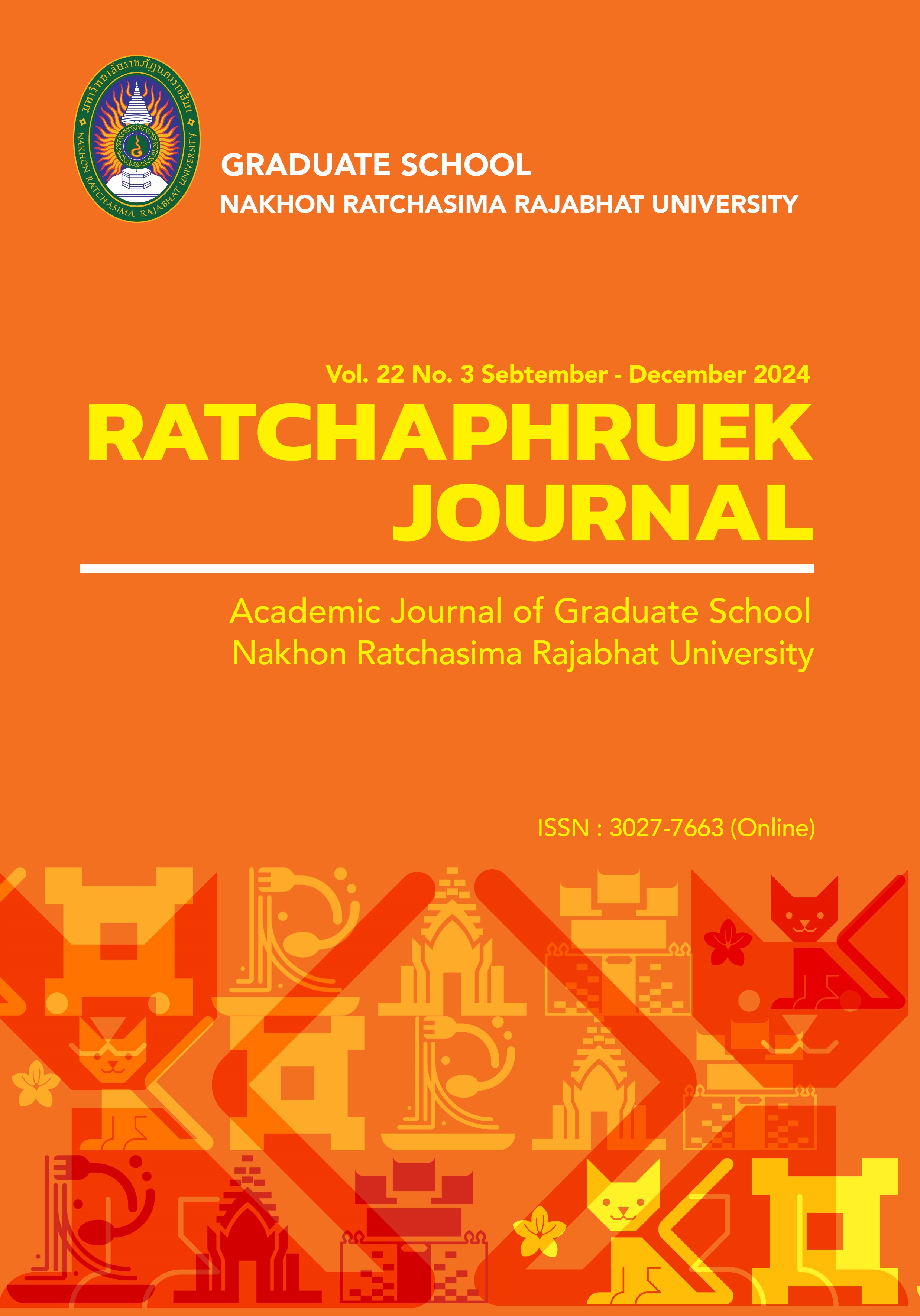An Innovation Model for Enhancing Innovator Competency in Educational Institutions Affiliated with the Bangkok Vocational Education Institute: A Management System Utilizing Dashboard-Based Administrative Data Visualization
Main Article Content
Abstract
The purpose of this research was to analyze needs and develop a model for developing students' innovator competencies. The study was divided into 2 phases: Phase 1: analysis of needs for competency development; Phase 2: development of innovation prototypes for developing innovator competencies with a management system that displays administrative data on dashboards. The sample group used in the research consisted of executives; research division supervisors, 39 person teachers for in-depth data collection, and 5 experts in innovative technology for evaluating the suitability of the prototype. The tools used were an in-depth interview form and a prototype innovation evaluation form. The content analysis found that Vocational Education Institutions want to develop students' innovative competencies; Creativity Problem-solving, Focus on achievement, Communication and Knowledge, and practice for the results of evaluating the appropriateness of the IDES Model innovation prototype consisting of I: Indicate, preparation step, D: Development, step of competency development according to design thinking, combining project-based learning management, consisting of understanding learners, identifying problems, brainstorming and planning. Developing innovative prototypes Testing and presenting the prototype E: Valuation, evaluation process and displaying dashboard management data (Dashboard) in the form of graphs, comparative statistics S: Success, the process of summarizing results and reflecting development results (Reflection) The suitability was at the highest level ( = 4.56, S.D. = 0.54).
Article Details

This work is licensed under a Creative Commons Attribution-NonCommercial-NoDerivatives 4.0 International License.
References
ขนิษฐา ม่วงศรีจันทร์. (2564). รูปแบบการบริหารเพื่อพัฒนาคุณลักษณะความเป็นนวัตกรของนักเรียนในโรงเรียนขยายโอกาสทางการศึกษา (วิทยานิพนธ์ดุษฎีบัณฑิต, มหาวิทยาลัยนเรศวร).
ชัยวิชิต เชียรชนะ. (2564). วิธีวิทยาการวิจัยชั้นสูง: การมุ่งเน้นการคิดเชิงวิพากษ์สำหรับการวิจัย. กรุงเทพฯ: ศูนย์ผลิตตำราเรียน มหาวิทยาลัยเทคโนโลยีพระจอมเกล้าพระนครเหนือ.
พิชญา กล้าหาญ และวิสูตร โพธิ์เงิน. (2564). การพัฒนากิจกรรมการเรียนรู้ตามแนวคิดกระบวนการคิดเชิงออกแบบร่วมกับการจัดการเรียนรู้โดยใช้โครงงานเป็นฐาน เพื่อส่งเสริมความเป็น นวัตกรของนักเรียนชั้นมัธยมศึกษาปีที่ 4. วารสารครุศาสตร์ จุฬาลงกรณ์มหาวิทยาลัย, 49(2), น. 1-5.
ปิยนันต์ คล้ายจันทร์. (2564). รูปแบบการเสริมสร้างความเป็นนวัตกรสำหรับหลักสูตรระดับปริญญาตรีของมหาวิทยาลัยเอกชนในประเทศไทย. วารสารสังคมศาสตร์และมานุษยวิทยาเชิงพุทธ, 6(8), น. 236-250.
มุจลินทร์ ผลกล้า. (2558). KmFL Model เพื่อการพัฒนาสมรรถนะการจัดการความรู้และสมรรถนะนวัตกรรมของสำนักวิทยบริการและเทคโนโลยีสารสนเทศ มหาวิทยาลัยราชภัฏ. วารสารวิทยบริการ มหาวิทยาลัยสงขลานครินทร์, 26(3), น. 1-16.
วราพร เอราวรรณ์ และประวิต เอราวรรณ์. (2555). วิธีการทางสถิติสำหรับการวิจัย (พิมพ์ครั้งที่ 6). กาฬสินธุ์: ประสานการพิมพ์.
วิชัย วงษ์ใหญ่ และมารุต พัฒผล. (2562). การจัดการเรียนรู้ในยุค Disruptive Innovation. กรุงเทพฯ: ศูนย์ผู้นำนวัตกรรมหลักสูตรและการเรียนรู้. สืบค้นเมื่อ 20 พฤษภาคม 2567, จาก http://www.curriculumandlearning.com/20Innovation_1544646601.pdf
ศูนย์ประสานงานสถาบันการอาชีวศึกษา. (2565). รายงานผลการดำเนินงานประจำปี ปีงบประมาณ พ.ศ. 2564. กรุงเทพฯ: สำนักงานคณะกรรมการการอาชีวศึกษา. สืบค้นเมื่อ 9 มิถุนายน 2564, จาก https://ivec.vec.go.th/
สถาบันการอาชีวศึกษากรุงเทพมหานคร. (2561) แนวทางการพัฒนาหลักสูตร. กรุงเทพฯ: สำนักงานคณะกรรมการการอาชีวศึกษา. สืบค้นเมื่อ 9 มิถุนายน 2564, จาก https://www.iveb. ac.th/th/vocational/bachelor_of_technology_program.pdf
สำนักงานพัฒนาเศรษกิจและสังคมแห่งชาติ. (2564). แผนพัฒนาเศรษฐกิจและสังคมแห่งชาติ ฉบับที่ 13 (พ.ศ. 2566-2570). กรุงเทพฯ: สำนักนายกรัฐมนตรี.
สำนักเลขาสภาการศึกษา. (2561). มาตรฐานการศึกษาของชาติ พ.ศ. 2561. กรุงเทพฯ: กระทรวงศึกษาธิการ.
สำนักงานคณะกรรมการการอาชีวศึกษา. (2567). ประกาศสำนักงานคณะกรรมการการอาชีวศึกษา เรื่อง นโยบายการพัฒนาอาชีวศึกษา ของสำนักงานคณะกรรมการการอาชีวศึกษา ประจำปีงบประมาณ พ.ศ. 2567. สืบค้นเมื่อ 9 มิถุนายน 2564, จาก https://url.in.th/qRHhQ
อภิยศ เหรียญวิพัฒน์. (2563). การวิเคราะห์ข้อมูลเพื่อสร้าง Dashboard แสดงสถิติการใช้บริการกึ่งเรียลไทม์ของสำนักหอสมุด มหาวิทยาลัยเกษตรศาสตร์. ใน การประชุมวิชาการระดับชาติ PULINET ครั้งที่ 10 (น. 2). สงขลา: สำนักหอสมุด มหาวิทยาลัยทักษิณ ร่วมกับ ข่ายงานห้องสมุดมหาวิทยาลัยส่วนภูมิภาค (PULINET).
Dudovskiy, J. (2021). Apple value chain analysis. Retrieved September 9, 2024, from https://research-methodology.net/apple-value-chain-analysis/
Dyer, J., Gregersen, H. & Chistensen, C. M. (2011). The innovator's DNA: Mastering the five skills of disruptive Innovators. Massachusetts: Harvard Business School.
Miles, M. B. & Huberman, A. M. (1994). Qualitative Data Analysis. An Expanded Sourcebook (2nd ed.). Thousand Oaks, CA: Sage.
Panit, W. (2012). The Way of Learning for 21st Century Students. Bangkok: Tatata Publication.
The Stanford d.school Bootcamp Bootleg (HPI). (2010). An introduction to design thinking. Retrieved September 9, 2024, from https://dschool.stanford.edu/ resources/design-thinking-bootleg
Wagner, T. (2018). Creative innovations: The making of young people who will change the world. New York: Scribner.


